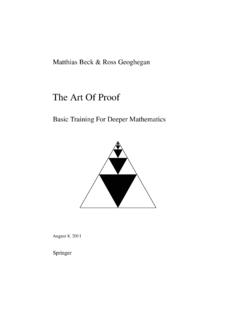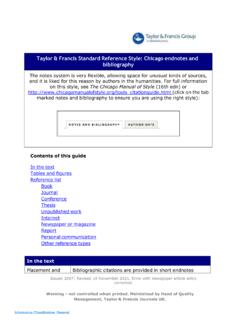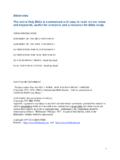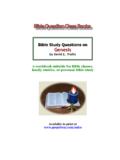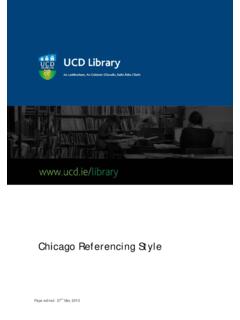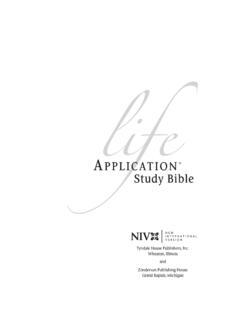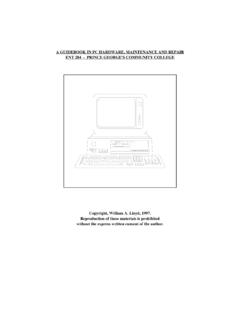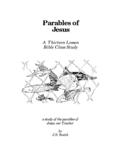Transcription of Matthias Beck Gerald Marchesi Dennis Pixton Lucas Sabalka
1 Matthias Beck Gerald Marchesi Dennis Pixton Lucas Sabalka Version A First Course in Complex Analysis Version Matthias Beck Gerald Marchesi Department of Mathematics Department of Mathematical Sciences San Francisco State University Binghamton University (SUNY). San Francisco, CA 94132 Binghamton, NY 13902. Dennis Pixton Lucas Sabalka Department of Mathematical Sciences Lincoln, NE 68502. Binghamton University (SUNY) Binghamton, NY 13902. Copyright 2002 2017 by the authors. All rights reserved. The most current version of this book is available at the website This book may be freely reproduced and distributed, provided that it is reproduced in its entirety from the most recent version. This book may not be altered in any way, except for changes in format required for printing or other distribution, without the permission of the authors.
2 The cover illustration, Square Squared by Robert Chaffer, shows two superimposed images. The foreground image represents the result of applying a transformation, z 7 z2 (see Exercises and ), to the background image. The locally conformable property of this mapping can be observed through matching the line segments, angles, and Sierpinski triangle features of the background image with their respective images in the foreground figure. (The foreground figure is scaled down to about 40% and repositioned to accommodate artistic and visibility considerations.). The background image fills the square with vertices at 0, 1, 1 + i, and i (the positive direction along the imaginary axis is chosen as downward). It was prepared by using Michael Barnsley's chaos game, capitalizing on the fact that a square is self tiling, and by using a fractal-coloring method.
3 (The original art piece is in color.) A subset of the image is seen as a standard Sierpinski triangle. The chaos game was also re-purposed to create the foreground image. And what is the use of a book, thought Alice, without pictures or conversations? . Lewis Carroll (Alice in Wonderland). About this book. A First Course in Complex Analysis was written for a one-semester undergradu- ate course developed at Binghamton University (SUNY) and San Francisco State University, and has been adopted at several other institutions. For many of our students, Complex Analysis is their first rigorous analysis (if not mathematics) class they take, and this book reflects this very much. We tried to rely on as few concepts from real analysis as possible. In particular, series and sequences are treated from scratch, which has the consequence that power series are introduced late in the course.
4 The goal our book works toward is the Residue Theorem, including some nontraditional applications from both continuous and discrete mathematics. A printed paperback version of this open textbook is available from Orthogonal Publishing ( ) or your favorite online bookseller. About the authors. Matthias Beck is a professor in the Mathematics Department at San Francisco State University. His research interests are in geometric combinatorics and analytic number theory. He is the author of two other books, Computing the Continuous Discretely: Ingeger-point Enumeration in Polyhedra (with Sinai Robins, Springer 2007) and The Art of Proof: Basic Training for Deeper Mathematics (with Ross Geoghegan, Springer 2010). Gerald Marchesi is a lecturer in the Department of Mathematical Sciences at Binghamton University (SUNY).
5 Dennis Pixton is a professor emeritus in the Department of Mathematical Sciences at Bingham- ton University (SUNY). His research interests are in dynamical systems and formal languages. Lucas Sabalka is an applied mathematician at a technology company in Lincoln, Nebraska. He works on 3-dimensional computer vision applications. He was formerly a professor of mathematics at St. Louis University, after postdoctoral positions at UC Davis and Binghamton University (SUNY). His mathematical research interests are in geometric group theory, low dimensional topology, and computational algebra. Robert Chaffer (cover art) is a professor emeritus at Central Michigan University. His academic interests are in abstract algebra, combinatorics, geometry, and computer applications. Since retirement from teaching, he has devoted much of his time to applying those interests to creation of art images ( From Mathematics).
6 A Note to Instructors. The material in this book should be more than enough for a typical semester-long undergraduate course in complex analysis; our experience taught us that there is more content in this book than fits into one semester. Depending on the nature of your course and its place in your department's overall curriculum, some sections can be either partially omitted or their definitions and theorems can be assumed true without delving into proofs. chapter 10. contains optional longer homework problems that could also be used as group projects at the end of a course. We would be happy to hear from anyone who has adopted our book for their course, as well as suggestions, corrections, or other comments. Acknowledgements. We thank our students who made many suggestions for and found errors in the text.
7 Special thanks go to Sheldon Axler, Collin Bleak, Pierre-Alexandre Bliman, Matthew Brin, John McCleary, Sharma Pallekonda, Joshua Palmatier, and Dmytro Savchuk for comments, suggestions, and additions after teaching from this book. We thank Lon Mitchell for his initiative and support for the print version of our book with Orthogonal Publishing, and Bob Chaffer for allowing us to feature his art on the book's cover. We are grateful to the American Institute of Mathematics for including our book in their Open Textbook Initiative ( ). Contents 1 Complex Numbers 1. Definitions and Algebraic Properties .. 2. From Algebra to Geometry and Back .. 4. Geometric Properties .. 8. Elementary Topology of the Plane .. 10. Exercises .. 13. Optional Lab .. 18. 2 Differentiation 19. Limits and Continuity.
8 19. Differentiability and Holomorphicity .. 22. The Cauchy Riemann Equations .. 26. Constant Functions .. 29. Exercises .. 30. 3 Examples of Functions 33. M bius Transformations .. 33. Infinity and the Cross Ratio .. 35. Stereographic Projection .. 39. Exponential and Trigonometric Functions .. 42. Logarithms and Complex Exponentials .. 44. Exercises .. 47. 4 Integration 53. Definition and Basic Properties .. 53. Antiderivatives .. 57. Cauchy's Theorem .. 60. Cauchy's Integral Formula .. 64. Exercises .. 67. 5 Consequences of Cauchy's Theorem 72. Variations of a Theme .. 72. Antiderivatives Again .. 75. Taking Cauchy's Formulas to the Limit .. 76. Exercises .. 78. 6 Harmonic Functions 82. Definition and Basic Properties .. 82. Mean-Value and Maximum/Minimum Principle .. 85. Exercises .. 88.
9 7 Power Series 90. Sequences and Completeness .. 91. Series .. 93. Sequences and Series of Functions .. 98. Regions of Convergence .. 101. Exercises .. 104. 8 Taylor and Laurent Series 109. Power Series and Holomorphic Functions .. 109. Classification of Zeros and the Identity Principle .. 114. Laurent Series .. 117. Exercises .. 121. 9 Isolated Singularities and the Residue Theorem 127. Classification of Singularities .. 127. Residues .. 132. Argument Principle and Rouch 's Theorem .. 135. Exercises .. 138. 10 Discrete Applications of the Residue Theorem 141. Infinite Sums .. 141. Binomial Coefficients .. 142. Fibonacci Numbers .. 143. The Coin-Exchange Problem .. 143. Dedekind Sums .. 145. Appendix: Theorems from Calculus 146. Solutions to Selected Exercises 148. Index 152. chapter 1. Complex Numbers Die ganzen Zahlen hat der liebe Gott geschaffen, alles andere ist Menschenwerk.
10 (God created the integers, everything else is made by humans.). Leopold Kronecker (1823 1891). The real numbers have many useful properties. There are operations such as addition, subtraction, and multiplication, as well as division by any nonzero number. There are useful laws that govern these operations, such as the commutative and distributive laws. We can take limits and do calculus, differentiating and integrating functions. But you cannot take a square root of 1; that is, you cannot find a real root of the equation x2 + 1 = 0 . ( ). Most of you have heard that there is a new number i that is a root of ( ); that is, i2 + 1 = 0. or i2 = 1. We will show that when the real numbers are enlarged to a new system called the complex numbers, which includes i, not only do we gain numbers with interesting properties, but we do not lose many of the nice properties that we had before.

